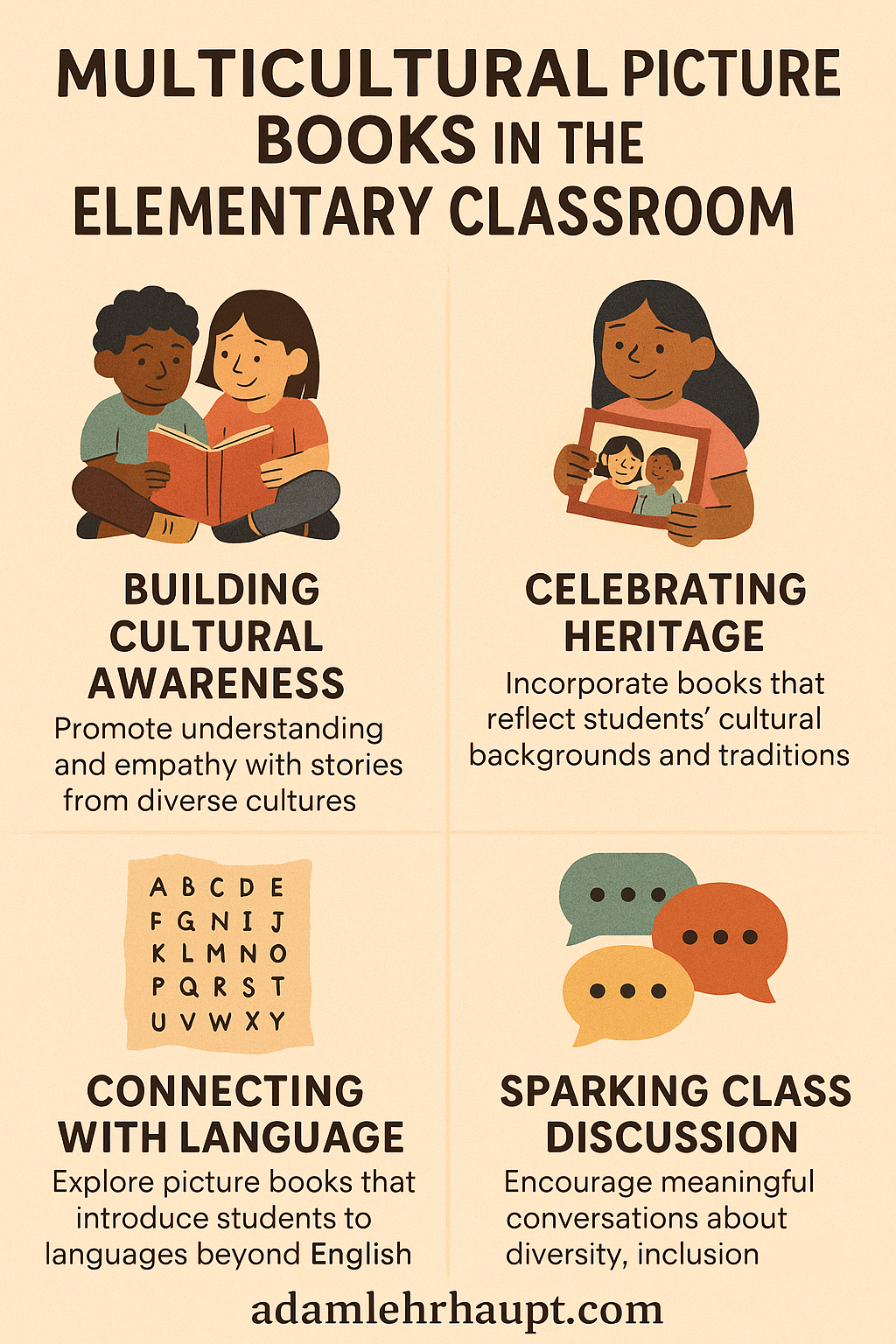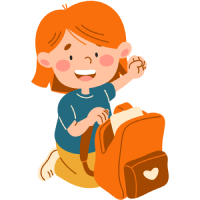Ever had that “oh no” moment when you realize your social studies unit on “culture” is basically… a food day and a few YouTube videos? (Been there. Ate the cookies. Still felt guilty.)
Here’s the truth: teaching cultural awareness and family heritage doesn’t have to be a one-day parade of flags. It can be woven into the larger picture of how kids see themselves and the world, and using picture books to teach culture and family heritage might be your sneaky secret weapon. I recently talked with Matthew Winner — award-winning librarian, host of The Children’s Book Podcast, and all-around expert in using books to connect with kids — about how he uses titles like Narwhal and Jelly and Jacob’s Room to Choose to create inclusive, creative learning spaces. And here’s the kicker: his strategies don’t just help kids understand other cultures; they help them explore their own.
TL;DR – Key Takeaways:
- Picture books are conversation starters, not just read-aloud filler.
- Use books that invite student response — drawing, writing, sharing personal stories.
- Integrate family heritage into projects for social studies, art, AND language arts.
- Focus on books with space for diverse interpretations, like Click, Clack! Smack! or Jacob’s Room to Choose.
- Download the free Exploring Personal and Familial History Lesson Guide.
1. The “Culture Day” Problem & How Using Picture Books to Teach Culture and Family Heritage Fixes It
The Problem: Many cultural awareness lessons end up feeling like check-the-box activities — quick, superficial, and disconnected from students’ real lives. Kids don’t always see themselves in those lessons, and without personal connection, the learning doesn’t stick.
Picture Book Solution: Click, Clack! Smack!: A Cherokee Stickball Story by Traci Sorell, illustrated by Joseph Erb
- Why it works: It introduces students to Cherokee culture through the sport of stickball — without turning the lesson into a lecture. It’s action-driven, relatable (hello, sports!), and leaves room for deeper discussion.
- Activity Idea: After reading, have students compare a sport or game from their own family or culture to stickball. They can interview a family member, sketch the equipment, or write a mini-rulebook.
Curriculum Connections:
- Social Studies: Cultural traditions, community roles, indigenous studies.
- ELA: Compare/contrast writing, informational text features.
- Art: Illustrating sports scenes or creating cultural game posters.
Real Talk: This isn’t a “throw it in on Friday” lesson. Give it a full block or two. The payoff is worth it when kids start saying, “Oh! My grandpa taught me a game like that.” Authentic representation matters — not just in the characters we see, but in the languages and cultural contexts they inhabit. The team at Diverse BookFinder has an insightful piece on representing language and cultural identity in picture books, which reinforces why Using Picture Books to Teach Culture and Family Heritage resonates so deeply with students.
Pro Tip: Keep a printed glossary handy (like the Cherokee glossary in Click, Clack! Smack!) so students can reference it during follow-up activities. It builds confidence in pronouncing and using new words.
2. From Pages to Personal History
The Problem: Students often know surprisingly little about their own family’s traditions or heritage — and teachers aren’t always sure how to integrate that into core subjects without going off-curriculum.
Picture Book Solution: Alma and How She Got Her Name by Juana Martinez-Neal
- Why it works: It’s short, sweet, and perfectly designed to get kids talking about where they come from.
- Activity Idea: Use a simple graphic organizer for students to record the story of their own name, a family tradition, or a special object from home.
Curriculum Connections:
- Social Studies: Family history, cultural identity.
- Writing: Personal narratives, sequencing events.
- Speaking & Listening: Sharing stories in small groups.
Real Talk: Not every student will know details of their heritage. Be ready with alternate prompts like “Tell me about a family tradition you’ve started” or “Describe a place that’s special to your family.”
Pro Tip: Pair students with buddies so they can interview each other before writing. Kids are often more comfortable sharing stories with peers than standing in front of the class cold.
3. Building Cultural Awareness Through Everyday Reads
The Problem: We often treat multicultural books as “special” instead of standard. This unintentionally sends the message that diverse perspectives are exceptions, not part of everyday learning.
Picture Book Solution: Narwhal and Jelly series by Ben Clanton
- Why it works: While not overtly about culture, its approachable format (graphic novel + simple dialogue) can be used as a model for telling personal or cultural stories in comic form.
- Activity Idea: Have students create a 4-panel comic about a family tradition, food, or celebration, using Narwhal and Jelly’s style.
Curriculum Connections:
- Art: Comic layout, character design.
- ELA: Dialogue writing, sequencing.
- Social Studies: Representing cultural practices visually.
Real Talk: Comics level the playing field for reluctant writers — but you’ll need to model a few examples first or you’ll end up with 30 panels of “Narwhal eats a taco.” Not every book claiming to be ‘multicultural’ is equally effective in the classroom. I like to lean on trusted resources for vetting titles, like this guide on choosing the best multicultural picture books from Reading Rockets, which helps ensure the stories we share are both authentic and developmentally appropriate.
Pro Tip: Use Ben Clanton’s “how to draw” pages (found in the books) to help students get started quickly without stressing over artistic ability.
4. Tackling Tough Topics with Care
The Problem: Teachers sometimes shy away from books on identity, gender, or equity for fear of “saying the wrong thing” — which means students miss out on important, age-appropriate conversations.
Picture Book Solution: Jacob’s Room to Choose by Sarah and Ian Hoffman
- Why it works: It handles gender identity in a straightforward, affirming way that invites questions without overwhelming younger readers.
- Activity Idea: Use the story to spark a class discussion on respect, kindness, and inclusion. Students can create “Welcome to Our School” posters that highlight their community’s values.
Curriculum Connections:
- SEL: Empathy, inclusion, conflict resolution.
- ELA: Opinion writing (“Why respect matters in our school”).
- Art: Collaborative poster design.
Real Talk: You don’t need to have all the answers — you just need to create space for respectful conversation. If a question stumps you, it’s okay to say, “Let’s find out together.”
Pro Tip: Partner with your school librarian or counselor for co-teaching these lessons; they can help manage sensitive questions and provide additional resources. And check out this post on ways to work sensitive topics into your planning. It’s a great add on to using picture books to teach culture and heritage.
Bonus Ideas for Going Deeper
- Cross-Curricular: Pair Click, Clack! Smack! with a PE lesson where students try a simplified version of stickball.
- Family Engagement: Send home a “Family Heritage Interview” worksheet for kids to complete with relatives.
- Tech Tie-In: Use a classroom friendly video app for students to record and share their personal stories with classmates.
- Art Integration: Create a hallway display of student comics and heritage posters as a “Hall of Stories.”
- If you’re looking to expand beyond the few titles we’ve talked about today, PBS Parents has a fantastic roundup of picture books to celebrate diversity — a great starting point for creating a year-round culture of inclusion.
Conclusion
Picture books aren’t just for quiet reading time — they’re tools for building identity, empathy, and understanding. By using picture books to teach culture and heritage you’ll integrate cultural awareness and family heritage into everyday lessons, you’re not just teaching students about others; you’re helping them understand themselves.
Start small. Pick one book, one activity, and one conversation starter. The ripple effect in your classroom culture will be bigger than you think.
💌 Want more ready-to-use lesson plans & book lists? Sign up for my weekly Picture This newsletter and get exclusive teaching tips, free resources, and creative ideas to make picture books the best part of your curriculum.
FAQ
How do I adapt these lessons for K–2?
Focus on drawing and oral storytelling rather than long written pieces. Using picture books to teach culture and heritage works well for every level. Download the Exploring Personal and Familial History Lesson Guide for more great ideas for leveling these and other activities.
What if students don’t know their heritage?
Give flexible prompts — family traditions, favorite meals, or celebrations all work. Or let them pick a tradition from a culture they admire.
How can I assess cultural awareness?
Adapt your rubrics for creativity, connection to theme, and effort — not just factual accuracy. Sometimes a family will adapt a tradition and celebrate it in their own way.
Can this fit into my ELA block?
Absolutely — tie it to narrative writing, sequencing, or compare/contrast.
How do I handle sensitive topics?
Prepare with clear class norms for respect and listening. Partner with support staff if needed. And check out my post here on ways to work sensitive topics into your planning.




